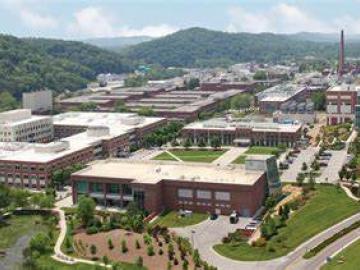Filter News
Area of Research
- Advanced Manufacturing (21)
- Biological Systems (1)
- Biology and Environment (25)
- Building Technologies (1)
- Clean Energy (80)
- Computational Biology (2)
- Computational Engineering (1)
- Fuel Cycle Science and Technology (1)
- Fusion and Fission (28)
- Fusion Energy (12)
- Isotope Development and Production (1)
- Isotopes (8)
- Materials (38)
- Materials for Computing (4)
- National Security (8)
- Neutron Science (19)
- Nuclear Science and Technology (36)
- Nuclear Systems Modeling, Simulation and Validation (2)
- Supercomputing (23)
News Type
News Topics
- (-) 3-D Printing/Advanced Manufacturing (106)
- (-) Advanced Reactors (29)
- (-) Biomedical (54)
- (-) Nuclear Energy (92)
- Artificial Intelligence (78)
- Big Data (42)
- Bioenergy (85)
- Biology (92)
- Biotechnology (19)
- Buildings (45)
- Chemical Sciences (52)
- Clean Water (27)
- Climate Change (84)
- Composites (23)
- Computer Science (171)
- Coronavirus (45)
- Critical Materials (22)
- Cybersecurity (34)
- Decarbonization (63)
- Education (3)
- Element Discovery (1)
- Emergency (2)
- Energy Storage (98)
- Environment (174)
- Exascale Computing (31)
- Fossil Energy (4)
- Frontier (34)
- Fusion (49)
- Grid (56)
- High-Performance Computing (74)
- Hydropower (11)
- Irradiation (2)
- Isotopes (44)
- ITER (7)
- Machine Learning (40)
- Materials (128)
- Materials Science (117)
- Mathematics (6)
- Mercury (12)
- Microelectronics (2)
- Microscopy (46)
- Molten Salt (8)
- Nanotechnology (54)
- National Security (49)
- Net Zero (10)
- Neutron Science (119)
- Partnerships (37)
- Physics (53)
- Polymers (27)
- Quantum Computing (28)
- Quantum Science (61)
- Renewable Energy (2)
- Security (22)
- Simulation (38)
- Software (1)
- Space Exploration (24)
- Statistics (2)
- Summit (55)
- Sustainable Energy (110)
- Transformational Challenge Reactor (7)
- Transportation (85)
Media Contacts

Rishi Pillai and his research team from ORNL will receive a Best Paper award from the American Society of Mechanical Engineers International Gas Turbine Institute in June at the Turbo Expo 2024 in London.

ORNL’s Erin Webb is co-leading a new Circular Bioeconomy Systems Convergent Research Initiative focused on advancing production and use of renewable carbon from Tennessee to meet societal needs.

Scientists at ORNL have developed 3D-printed collimator techniques that can be used to custom design collimators that better filter out noise during different types of neutron scattering experiments
ORNL scientists have determined how to avoid costly and potentially irreparable damage to large metallic parts fabricated through additive manufacturing, also known as 3D printing, that is caused by residual stress in the material.

Two different teams that included Oak Ridge National Laboratory employees were honored Feb. 20 with Secretary’s Honor Achievement Awards from the Department of Energy. This is DOE's highest form of employee recognition.

Three staff members in ORNL’s Fusion and Fission Energy and Science Directorate have moved into newly established roles facilitating communication and program management with sponsors of the directorate’s Nuclear Energy and Fuel Cycle Division.

New computational framework speeds discovery of fungal metabolites, key to plant health and used in drug therapies and for other uses.

Corning uses neutron scattering to study the stability of different types of glass. Recently, researchers for the company have found that understanding the stability of the rings of atoms in glass materials can help predict the performance of glass products.

Researchers at ORNL became the first to 3D-print large rotating steam turbine blades for generating energy in power plants.

Nuclear engineering students from the United States Military Academy and United States Naval Academy are working with researchers at ORNL to complete design concepts for a nuclear propulsion rocket to go to space in 2027 as part of the Defense Advanced Research Projects Agency DRACO program.




